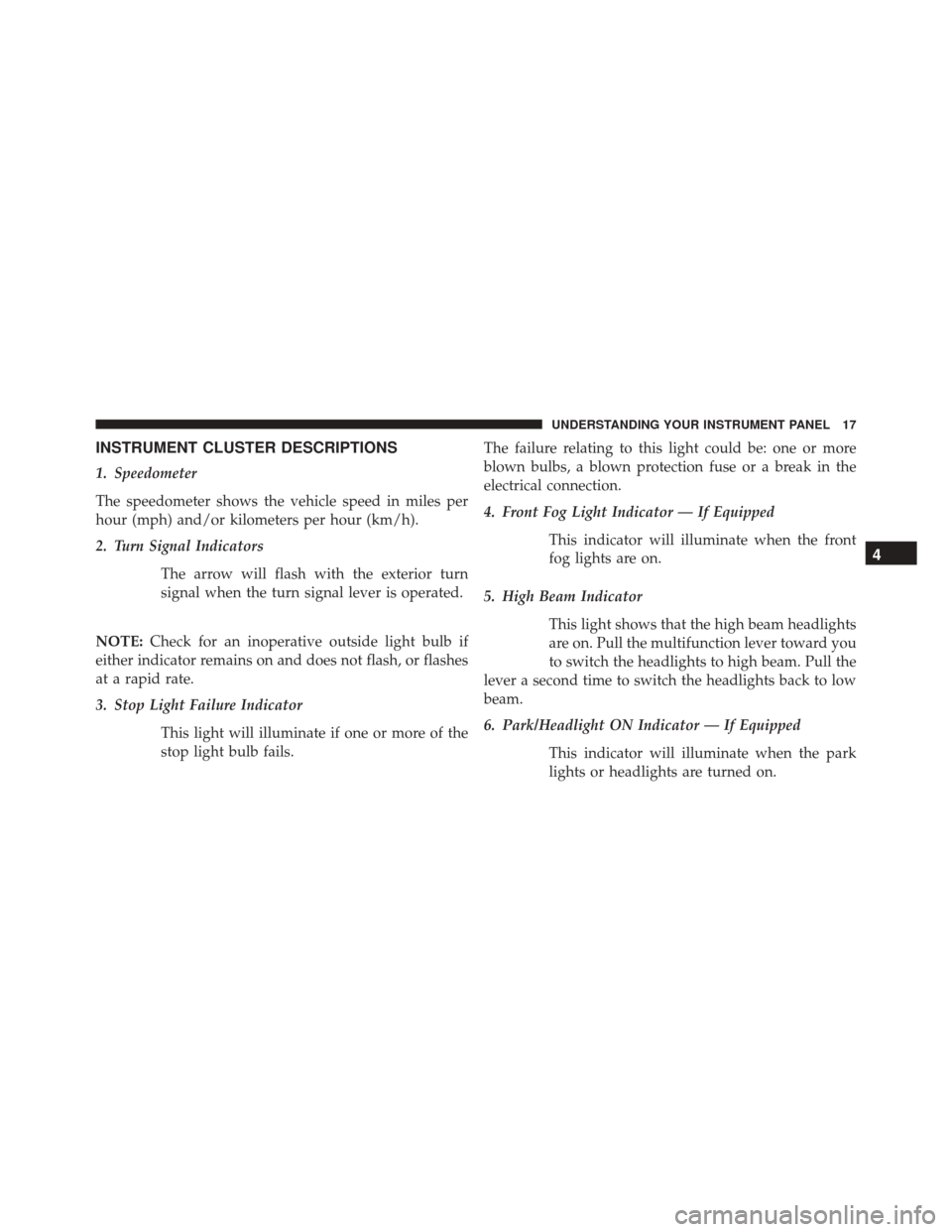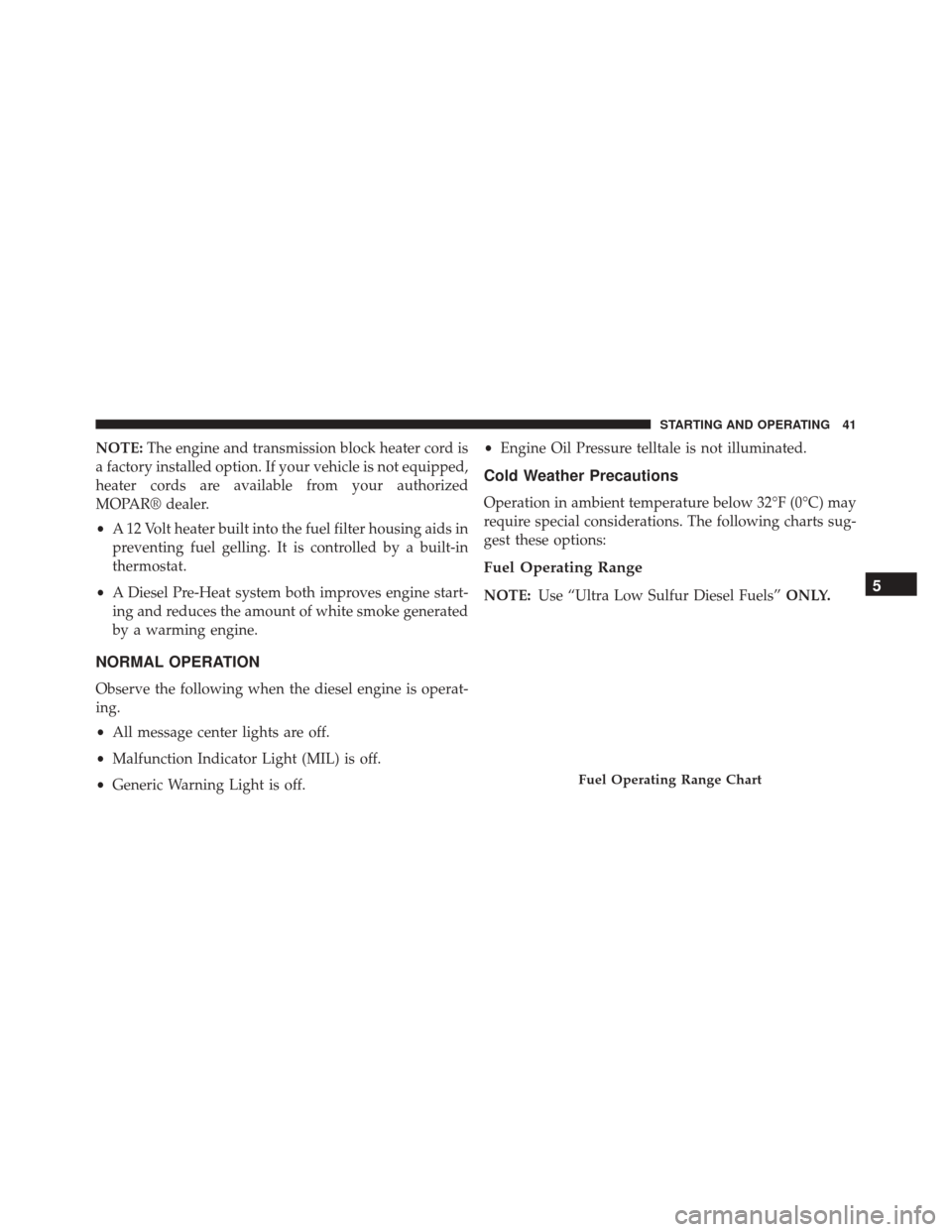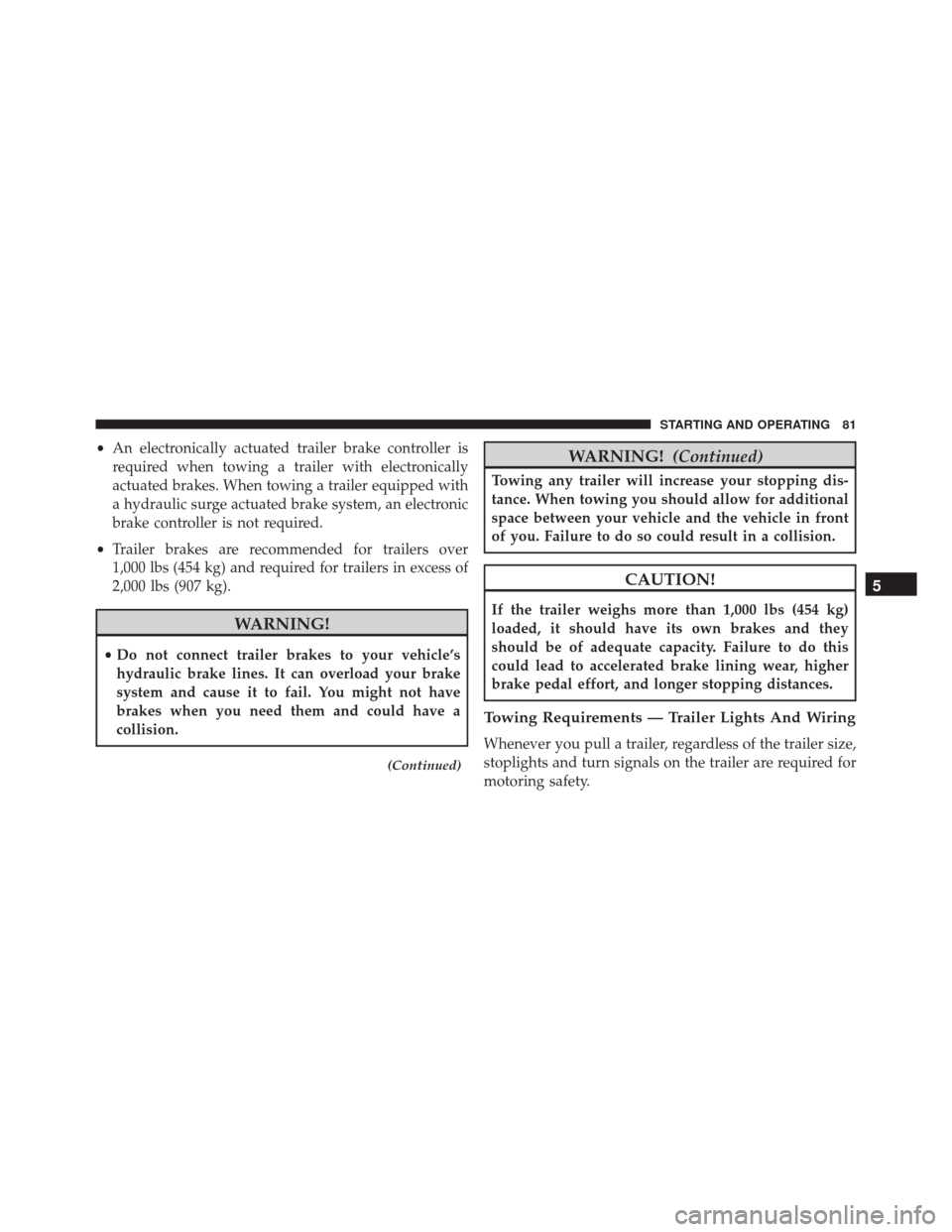2015 Ram ProMaster lights
[x] Cancel search: lightsPage 19 of 130

INSTRUMENT CLUSTER DESCRIPTIONS
1. Speedometer
The speedometer shows the vehicle speed in miles per
hour (mph) and/or kilometers per hour (km/h).
2. Turn Signal IndicatorsThe arrow will flash with the exterior turn
signal when the turn signal lever is operated.
NOTE: Check for an inoperative outside light bulb if
either indicator remains on and does not flash, or flashes
at a rapid rate.
3. Stop Light Failure Indicator
This light will illuminate if one or more of the
stop light bulb fails. The failure relating to this light could be: one or more
blown bulbs, a blown protection fuse or a break in the
electrical connection.
4. Front Fog Light Indicator — If Equipped
This indicator will illuminate when the front
fog lights are on.
5. High Beam Indicator This light shows that the high beam headlights
are on. Pull the multifunction lever toward you
to switch the headlights to high beam. Pull the
lever a second time to switch the headlights back to low
beam.
6. Park/Headlight ON Indicator — If Equipped
This indicator will illuminate when the park
lights or headlights are turned on.
4
UNDERSTANDING YOUR INSTRUMENT PANEL 17
Page 20 of 130

7. Odometer/Trip Odometer/Electronic Vehicle Informa-
tion Center (EVIC) Display Area
This display indicates the total distance the vehicle has
been driven.
U.S. Federal regulations require that upon transfer of
vehicle ownership, the seller certify to the purchaser the
correct mileage that the vehicle has been driven. If your
odometer needs to be repaired or serviced, the repair
technician should leave the odometer reading the same
as it was before the repair or service. If s/he cannot do so,
then the odometer must be set at zero, and a sticker must
be placed in the door jamb stating what the mileage was
before the repair or service. It is a good idea for you to
make a record of the odometer reading before the repair/
service, so that you can be sure that it is properly reset, or
that the door jamb sticker is accurate if the odometer
must be reset at zero.Shift Lever Position/Transmission Gear Range
The transmission gear range “R, N, D, 1, 2, 3, 4, 5, 6” is
displayed in the EVIC whenever the engine is running.
With key on/engine off, the display may indicate the
shift lever position rather than the actual transmission
gear position. Refer to “Shift Lever/Transmission Gear
Position” under “Automated Manual Transmission” for
further information.
8. External Light Failure Indicator — If Equipped
The External Light Failure Indicator will come on when a
failure to one of the following lights is detected:
•Side Marker Lights
• Direction Indicators
• Backup Lights
• Parking Lights
• Daytime Running Lamps (DRL)
• Clearance Lights
• License Plate Lights
18 UNDERSTANDING YOUR INSTRUMENT PANEL
Page 21 of 130

The failure relating to these lights could be: one or more
blown bulbs, a blown protection fuse or a break in the
electrical connection.
9. Door Ajar IndicatorThis indicator will illuminate when one or
more door(s) are not fully closed.
10. Glow Plug Light — If Equipped
This vehicle will inhibit engine cranking when the
transmission oil temperature is less than –22° F
(–30° C) and the oil temperature sensor reading indicates an
engine block heater has not been used. The Glow Plug light
will flash during in cold weather for up to 10 seconds. An
externally powered electric engine block heater is available
as optional equipment or from your authorized dealer.
Turning the ignition key to the ON/RUN position illu-
minates the Glow Plug Light, the light will turn off when glow plugs reach the established temperature. You can
start the engine immediately after the light turns off.
A blinking Glow Plug Light (together with a display
message) indicates a failure on glow plugs. Please see
your authorized dealer as soon as possible.
11. Tachometer
The tachometer indicates engine speed in Revolutions
Per Minute (RPM x 1000).
CAUTION!
Do not operate the engine with the tachometer
pointer at high RPM for extended periods. Engine
operation over 3200 RPM can result in significant
damage that will not be covered under the New
Vehicle Limited Warranty.
4
UNDERSTANDING YOUR INSTRUMENT PANEL 19
Page 40 of 130

Normal Starting Procedure
The shift lever must be in the NEUTRAL (N) position,
and the brake pedal must be pressed, to allow engine
cranking. Place the shift lever in NEUTRAL (N) and
apply the brake pedal BEFORE turning the key to the
START/AVV position; otherwise, the engine will not
crank and the key must be cycled OFF, then back on,
before cranking is allowed.
Observe the instrument panel cluster lights when starting
the engine.
NOTE:Normal starting of either a cold or a warm
engine is obtained without pumping or pressing the
accelerator pedal.
1. Press and hold the brake pedal.
2. Place the shift lever into the NEUTRAL (N) position while keeping the brake pedal depressed. 3. Turn the ignition switch to the ON/RUN/MAR posi-
tion and watch the instrument panel cluster lights.
CAUTION!
If the “Generic Warning Light” remains on and a
“Service Fuel Filter” message displays, DO NOT
START engine before you drain the water from the
fuel filter housing to avoid engine damage. Please
see your authorized dealer for draining the fuel
filter/water separator and fuel filter replacement.
4. After the Glow Plug light turns off, turn the ignition switch to the AVV (START) position to start the engine.
Do not press the accelerator during starting.
5. If you wish to stop the cranking of the engine prior to the engine starting, release the ignition key so that it
turns back to the ON/RUN position.
38 STARTING AND OPERATING
Page 43 of 130

NOTE:The engine and transmission block heater cord is
a factory installed option. If your vehicle is not equipped,
heater cords are available from your authorized
MOPAR® dealer.
• A 12 Volt heater built into the fuel filter housing aids in
preventing fuel gelling. It is controlled by a built-in
thermostat.
• A Diesel Pre-Heat system both improves engine start-
ing and reduces the amount of white smoke generated
by a warming engine.
NORMAL OPERATION
Observe the following when the diesel engine is operat-
ing.
• All message center lights are off.
• Malfunction Indicator Light (MIL) is off.
• Generic Warning Light is off. •
Engine Oil Pressure telltale is not illuminated.
Cold Weather Precautions
Operation in ambient temperature below 32°F (0°C) may
require special considerations. The following charts sug-
gest these options:
Fuel Operating Range
NOTE: Use “Ultra Low Sulfur Diesel Fuels” ONLY.
Fuel Operating Range Chart
5
STARTING AND OPERATING 41
Page 83 of 130

•An electronically actuated trailer brake controller is
required when towing a trailer with electronically
actuated brakes. When towing a trailer equipped with
a hydraulic surge actuated brake system, an electronic
brake controller is not required.
• Trailer brakes are recommended for trailers over
1,000 lbs (454 kg) and required for trailers in excess of
2,000 lbs (907 kg).
WARNING!
• Do not connect trailer brakes to your vehicle’s
hydraulic brake lines. It can overload your brake
system and cause it to fail. You might not have
brakes when you need them and could have a
collision.
(Continued)
WARNING! (Continued)
Towing any trailer will increase your stopping dis-
tance. When towing you should allow for additional
space between your vehicle and the vehicle in front
of you. Failure to do so could result in a collision.
CAUTION!
If the trailer weighs more than 1,000 lbs (454 kg)
loaded, it should have its own brakes and they
should be of adequate capacity. Failure to do this
could lead to accelerated brake lining wear, higher
brake pedal effort, and longer stopping distances.
Towing Requirements — Trailer Lights And Wiring
Whenever you pull a trailer, regardless of the trailer size,
stoplights and turn signals on the trailer are required for
motoring safety.
5
STARTING AND OPERATING 81
Page 114 of 130

MAINTENANCE SCHEDULE — DIESEL ENGINE
Your vehicle is equipped with an automatic oil change
indicator system. The oil change indicator system will
remind you that it is time to take your vehicle in for
scheduled maintenance.
Based on engine operation conditions, the oil change
indicator message will illuminate in the instrument clus-
ter. This means that service is required for your vehicle.
Operating conditions such as frequent short-trips, trailer
tow, and extremely hot or cold ambient temperatures will
influence when the “Oil Change Required” message is
displayed. Severe Operating Conditions can cause the
change oil message to illuminate as early as 3,500 miles
(5,600 km) since last reset. Have your vehicle serviced as
soon as possible, within the next 500 miles (805 km).
Your authorized dealer will reset the oil change indicator
message after completing the scheduled oil change. If a
scheduled oil change is performed by someone otherthan your authorized dealer, the message can be reset by
referring to the steps described under “Electronic Vehicle
Information Center (EVIC)” in “Understanding Your
Instrument Panel” for further information.
NOTE:
Under no circumstances should oil change inter-
vals exceed 18,500 miles (29,773 km) or twelve months,
whichever comes first.
Once A Month Or Before A Long Trip:
• Check engine oil level
• Check windshield washer fluid level
• Check the tire inflation pressures and look for unusual
wear or damage
• Check the fluid levels of the coolant reservoir, brake
master cylinder, and power steering and fill as needed
• Check function of all interior and exterior lights
112 MAINTENANCE SCHEDULE
Page 125 of 130

Diesel Fuel Requirements.................60, 106
Bulk Storage of .........................67
Diesel Fuel System, Re-Priming ................94
Disposal Antifreeze (Engine Coolant) ................101
Draining Fuel/Water Separator Filter ............93
Electronic Speed Control (Cruise Control) .........12
Electronic Vehicle Information Center (EVIC) ......30
Engine ..................................88
Air Cleaner ............................92
Block Heater ...........................45
Break-In Recommendations ..................8
Compartment ...........................88
Coolant (Antifreeze) .....................106
Fuel Requirements ..................... .105
Identification ...........................88
Idling ................................43
Oil........................... .90, 105, 106Oil Filler Cap
...........................91
Oil Selection .......................... .105
Filters Air Cleaner ............................92
Engine Fuel ............................93
Engine Oil ......................... .92, 106
Engine Oil Disposal ......................92
Flashers Turn Signal ............................17
Fluid Capacities ......................... .105
Fluid Level Checks Brake ............................... .103
Fluids, Lubricants and Genuine Parts ...........106
Fog Lights ...............................17
Fuel ................................ .60, 66
Adding ...............................66
Diesel ......................... .60, 66, 106
Filter ............................ .93, 106
8
INDEX 123